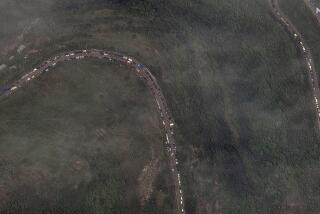Beyond Aleppo’s bustling market, the cost of Syria’s brutal civil war becomes clear

A third of the Old City quarter, a 1.4-square-mile labyrinth of elegant souks, was obliterated in the fighting; the rest was severely damaged. The area is now the focus of the government’s most vigorous efforts to rebuild.
At first glance, there is little indication of the vicious fighting that took place here.
Gone are the barriers at the exit of the market, Souk al Zarb. The citadel’s courtyard, once a no man’s land of dueling snipers, now is full of people taking selfies before a large #Believe_In_Aleppo sign. Instead of a haunting silence, there is the quotidian hum of traffic.
But it’s immediately clear from the picture of Syrian President Bashar Assad hanging from the ramparts of the citadel’s tower who won the battle for this city, and perhaps the war that has engulfed Syria for seven years.
Only when you look beyond the square, at the mountain of rubble that was the Carlton Hotel, or the hollowed-out remains of the historic municipal headquarters, the Grand Serail, do you begin to see the cost of that victory.
It has now been more than a year since the rebels who seized much of what was Syria’s largest city were finally driven out.
The four-year battle came to be known as Syria’s Stalingrad, and for those here now its conclusion — celebrated by the people who blamed the rebels for the onset of a ruinous war, lamented by the ones who saw the opposition’s defeat as the end of hope for Syria’s future — has left little time to contemplate the philosophical differences between the two sides.
People here are struggling to rebuild shattered lives — facing crippling power cuts, material shortages and a reconstruction process that seems to be held hostage to political maneuverings between the government and the international community.
A third of the Old City quarter, a 1.4-square-mile labyrinth of elegant souks, was obliterated in the fighting; the rest was severely damaged. The area is now the focus of the government’s most vigorous efforts to rebuild.
Bulldozers rumble by the perimeter of the Umayyad mosque, clearing away a 15-foot layer of dirt and debris to reveal the arches of ancient shop fronts.
It’s painstaking work, said Abdul Qader Mughrabi, a bespectacled worker making his way through a newly opened path leading to Souk al Saboun.
“We have to gather the ancient rocks from the dirt. We can’t lose any of them,” said Mughrabi. In some cases, confined spaces must be cleared with hands and shovels when a bulldozer won’t fit, or might inflict further damage.
Within the mosque, a craftsman hunches over a worktable, delicately placing alternating pieces of light and dark wood to form octagonal shapes; they will eventually make up a large wooden hemisphere for the mosque’s arches. (“Each covering takes a month to make. I’ll need 12 of them,” says the craftsman with a smile. “I come out of here feeling dizzy.”)
The government, in cooperation with the Aga Khan Foundation and Germany’s official relief agency, the German Technical Cooperation Agency, has prioritized the mosque’s restoration. But the astronomical expense of the renovation for other ancient areas (liable to run in the tens of billions of dollars, sums the cash-strapped central government in Damascus does not have) means residents and business owners must pick up the tab.
Over in the Old City’s Khan Kheirbek, Mahmoud Meimeh, a 60-year-old rug merchant, watches a workman strike an interior wall with a tooth-edged hammer, stamping the characteristic perforations in the stone’s face.
The rebels burned down Meimeh’s shop within days of taking over. He left, but soon returned to open a shop for army soldiers fighting nearby.
“There were only 200 yards between us and the militants,” he said, pointing to the other end of a walkway.
Now he is overseeing repair work in the area for a number of merchants. “It takes us two months to fix each of these with six workers, and it costs roughly $8,000,” says Meimeh, pulling at a brick.
It easily gives way, crumbling to the ground. He sighs.
“I was a man of means, I used to have four shops, and now I have to remove dirt?”
The uprisings that swept through Syria in 2011 as part of the so-called Arab Spring were slow to come to Aleppo. The tribal tensions in the country’s south and the explosive sectarian mix that had turned Homs into a bloodbath were largely absent here.
Instead the fight here became a battle of haves vs. have-nots: Antebellum Aleppo was Syria’s economic engine, with a moneyed merchant class fiercely proud of its entrepreneurial spirit and its rivalry with Damascus.
But the opposition attracted those in the countryside who had been left out of the economic prosperity and political power. Rebel factions — many of them Islamist —marched on sprawling industrial complexes outside the city, and finally entered it in July 2012.
They overran government positions and, at their peak, controlled 66 of the city’s 106 neighborhoods. Eastern Aleppo was touted as the foundation of their vision for Syria.
Meanwhile, both sides pummeled each other, the rebels with rockets, mortars and explosive gas canisters. The government added airstrikes to that mix. Whole neighborhoods became wastelands. More than 33,000 were estimated to have been killed; hundreds of thousands fled.
Those who stayed navigated between east and west Aleppo, scurrying behind streetwide shrouds draped between buildings (a foil for snipers) in neighborhoods like Bustan al Qasr, which became known as the “passageway of death.” Eventually even this passageway was closed, forcing residents on an 18-hour trek to traverse what had been once been a walk across the street.
By the end of 2016, the rebels, fragmented and exhausted by a government siege aided by Russia and Iran, relinquished control of the city, ending a battle that had come to symbolize the terrible cost of the war.
And Aleppo now is a city of contrasts.
Markets are busy. In the Tilal street market, one seller hawks brightly colored lingerie, his voice roaring through the street above the noise of the bustling pedestrians.
Hardware stores do brisk business as customers flock in to repair busted equipment. The city’s best-known food and sweets are omnipresent, a reminder that the city’s syncretic cuisine is a result of successive invasions and migrations.
Only a few checkpoints mark where the demarcation line between the government and rebel-held areas of the city used to be. A more potent reminder of the division is the devastation that lies on the side of the city once held by rebels.
In some neighborhoods, returning families catch their children toying with bullet casings as big as their hands. They play among buildings pocked like blocks of Swiss cheese.
But even here there is progress. More than 200,000 people have returned to eastern Aleppo, according to the United Nations, and in 2017 the governorate that includes Aleppo witnessed the largest number of returnees in the country.
A full engineering assessment of east Aleppo’s structures will be released soon, but for now aid groups have focused on the least damaged neighborhoods, providing light assistance for rehabilitation.
That means plywood, tarps and other items of an emergency shelter response kit. In some cases the U.N. gives up to $1,500 to homeowners, but even that is barely enough for lasting repairs.
The key is that it’s called rehabilitation, not reconstruction, and the difference is politically tricky.
With the rebels militarily weak, Assad’s Western and regional foes see offers of help in reconstruction, and the enormous funds it requires, as the only leverage they have to wring concessions from Damascus.
Sanctions have snarled rebuilding efforts too, with Syrian businesses unable to import many items or even pay for them in the first place.
And although all is calm in Aleppo, the war isn’t far away.
A few dozen miles to the northwest and southwest there is still fighting — and the legacy of that fighting is never far from people’s minds.
“People’s psychology has changed. You just don’t feel comfortable when you see the destruction,” said Ahmad Bateetah, a 21-year-old law student working at the Khan Kheirbek. “We’re not like we were.”
Bulos is a special correspondent.
Twitter: @nabihbulos
More to Read
Start your day right
Sign up for Essential California for news, features and recommendations from the L.A. Times and beyond in your inbox six days a week.
You may occasionally receive promotional content from the Los Angeles Times.







